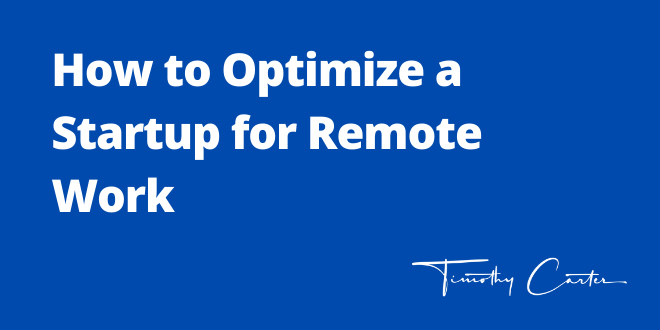
Getting Your First Rank One Position in Google: Everything You Need to Know
May 19, 2022
How Startup Founders Should Practice Creative Brainstorming
June 5, 2022Increasingly, startups are adopting a fully remote work model. With no headquarters, no central office, and no physical location for operations, startups rely entirely on digital forms of production and communication. Here is how to optimize a startup for remote work.
It’s a viable model and potentially a very profitable, efficient, and fulfilling one for everyone involved. But if you want to be successful, it’s not enough to simply adopt a remote work strategy—you have to optimize your startup for remote work.
Why Remote Work?
Remote work is in fashion these days, so many people already know the benefits — or at least some of the benefits. But if you want to make the most of your remote work optimization strategy, you should be familiar with the setup’s greatest strengths.
- Lower costs. Naturally, working remotely allows a startup to save money. You won’t have to pay thousands of dollars per month to lease an office. You won’t have to pay for office supplies or utilities. And your employees can save money too—they won’t need to pay as much for transportation, parking, or attire (in most cases).
- Bigger talent pool. Operating remotely also gives you access to a wider talent pool. Without a central location, you can feasibly hire employees from all over the world. That means you’ll have a much higher likelihood of finding the right person for each role on your team.
- Higher productivity. Studies show that people who work from home tend to be more productive than their counterparts in traditional workplaces. There are many proposed explanations for this effect, including greater employee comfort, fewer distractions, or even a sense of pressure to perform—so employees can retain the perceived benefit.
- Finally, remote work affords employees and employers with significant flexibility. Without a central office, consistent hours become less of a concern, and people feel more capable of utilizing a wide range of communication tools—rather than heading to the meeting room every time someone has a question or comment.
Of course, there are some downsides to remote work as well. For example, communication can be more challenging, you won’t benefit from the physical presence and brand exposure of an office building, and over time, your employees may suffer from burnout and/or loneliness. However, you can compensate for these with the right remote work optimization strategy.

The Nature of Remote Work Optimization
Remote work optimization is all about restructuring your business in a way that makes remote work even more efficient. It’s a way to play to the strengths of remote work while minimizing the weaknesses.
Note that remote work optimization isn’t just about making your business functional in a remote work environment. Many businesses transition to a remote work model in an overly straightforward and seemingly efficient way — but it’s the wrong way. In this approach, businesses simply take operations as they know them in a traditional work environment and shoehorn them into a remote work mold. It’s like fitting a square-shaped peg into a circle-shaped hole.
In this inefficient model, you might translate all previous in-person meetings into video conferences. You might make all employees work 9 to 5 like usual. You might even have lunch breaks at the exact same time and in the exact same way.
But if you want to achieve your true potential as an organization, you need to take a different approach. You need to structure your organization with remote work in mind, rethinking or restructuring work aspects from a fundamental level.
Key Principles for Success
How can you do this?
- Build a remote organization from the ground up. As a short-term, duct-tape style fix, it’s okay to create a remote work environment based on your traditional approach to work. But as a long-term fix, this is much harder to pull off successfully. Instead, tear down everything and try to rebuild from the ground up. With no traditions or expectations to fulfill, does it really make sense to have this daily meeting? Is there a better system of communication and collaboration that you can create?
- Prioritize digital visibility. Without a physical office, you’re not going to have much of a ground presence. That means you’ll be almost exclusively reliant on digital strategies for increasing visibility (like search engine optimization—SEO). Fortunately, there’s no shortage of digital marketing strategies to choose from, and many of them are highly cost-efficient. Try using a combination of content marketing, SEO, social media marketing, email marketing, and other digital outlets to make up the difference.
- Invest in the right tools. Without the office to bring people together, your team will rely on digital tools to accomplish their tasks, including communicating with other workers. Your choice of tools will dictate your team’s success; intuitive, efficient, functional tools will increase productivity, while inefficient, clunky ones can make remote work practically impossible. Don’t be afraid to invest a little more to get the right tools for your team.
- Embrace minimalism. That said, it’s possible to go overboard. If your team is overloaded with apps to use and tools to leverage, it’s going to be more of a burden than a help. It’s important to invest in good tools, but those tools should also be minimal and streamlined. There’s no reason to add a new tool to a system that works perfectly well as is.
- Rethink basic assumptions. Take the time to question and rethink even your most basic assumptions about work. For example, is the 9 to 5 workday really the optimal way for your team to spend their time? Are emails truly the most viable mode of consistent communication?
Hours and Compensation
One of the most important areas to consider is how your employees spend their hours. In many roles, the sheer number of hours a person spends doesn’t really matter. They have a set of responsibilities and a set of tasks to accomplish; as long as they accomplish these, they shouldn’t need to spend a certain number of hours or be present at certain hours of the day.
Many workplaces can afford to grant workers some flexibility in this regard. You may allow employees to set their own hours, or at least be accommodating with occasional deviations from the standard schedule. You may even change how you compensate employees, accordingly, paying them based on what they accomplish, rather than with a set salary or on an hourly basis.
Communication
Communication can make or break your remote team’s productivity, so it needs to be one of your biggest areas for development. Utilize many different communication channels, including things like email, project management platforms, video chats, phone calls, and instant message platforms. Each channel has strengths and weaknesses, so using many platforms simultaneously can balance.
However, you should know that while technology can solve many communication problems, it can also introduce some problems of its own. Scrutinize your communication channels carefully, and be careful not to overwhelm employees with too many apps or too many notifications.
Security
Working remotely introduces new security risks, so you’ll need to adjust your standards and procedures. Document new security policies for all employees to follow, and educate them on best practices like network connectivity and password management. Additionally, you’ll need to invest in tools like VPNs and firewalls to ensure your remote organization remains secure.
Feedback and Ongoing Changes
If you want to maximize productivity, efficiency, and morale in your remote organization, you’ll need to commit to making ongoing changes. Your initial systems and procedures won’t be perfect, and the only way to accommodate and improve those imperfections is to evolve.
Collect feedback from your employees to get a feel for how your remote work changes are playing out in practice. They may have suggestions for further changes to make or complaints about specific tools or setups. Listen to these notes and be prepared to address them, one way or another.
Optimizing a tech startup for remote work is much more than just saying goodbye to the office. If you want to succeed in this increasingly popular and competitive space, it’s important to take your strategic planning seriously.
Image Credit: anna shvets; pexels
Originally appeared in ReadWrite






